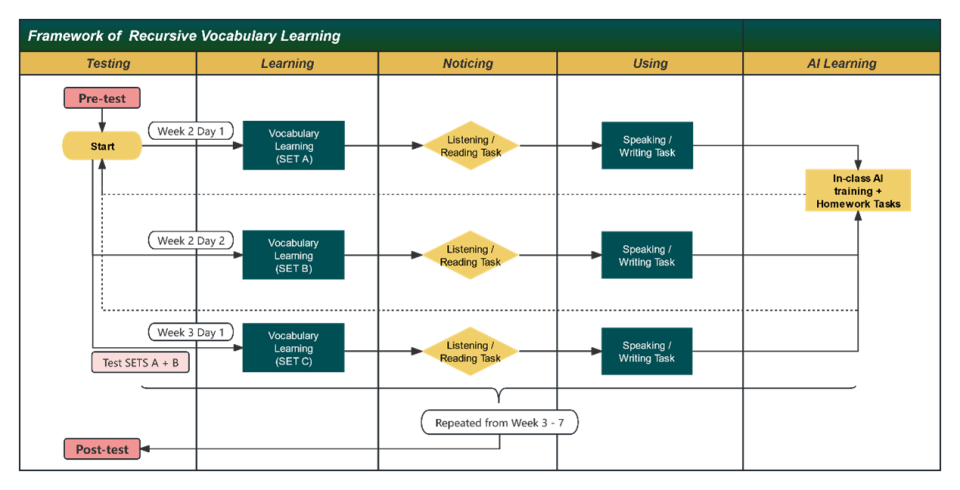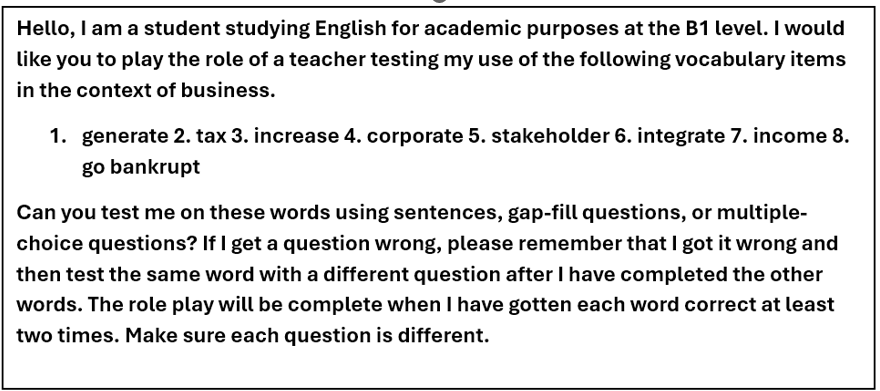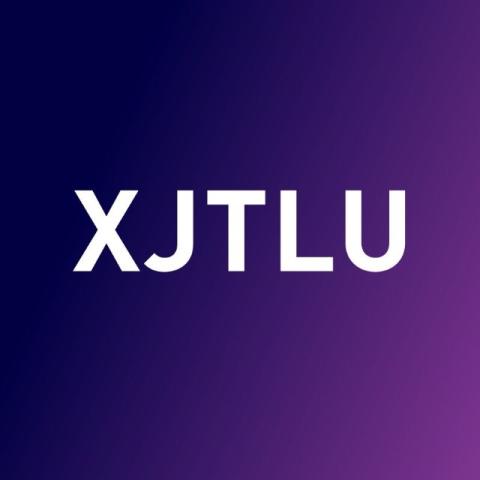
A new way of ensuring repeated EAP vocabulary exposure
David A. Wilkins wrote, “Without grammar very little can be conveyed, without vocabulary nothing can be conveyed.”
Learning new vocabulary is essential for success in English for academic purposes (EAP) courses, especially for first-year higher education students. However, many EAP curricula fail to expose students enough times to new vocabulary for it to become usefully available in their long-term memory.
This resource provides practical steps to enhance student vocabulary learning through a systematic approach. It uses a minimum of five meaningful activities with targeted words and a combination of traditional vocabulary learning activities, such as teacher-led learning, matching and text exposure, alongside modern generative AI tools. Educators outside of the EAP context may also find this approach useful when designing curricula to teach topic-specific jargon.
A vocabulary teaching framework for repeated exposure
At Xi’an Jiaotong-Liverpool University (XJTLU), we developed a systematic approach, known as the Recursive Vocabulary Teaching Framework (RVTF), which involves five key steps: learning, noticing, using, AI reviewing and testing. The overall aim is to have students engage with the target vocabulary at least five times, both through input (reading and listening) and output (speaking and writing).

- Learning: introduce new vocabulary using visuals, clear definitions and example sentences. Use interactive activities like bingo or matching exercises
- Noticing: reinforce vocabulary through reading or listening activities, followed by exercises where students identify and define new words in context
- Using: encourage practical application through speaking and writing activities. For example, have students create sentences or engage in role plays using the target vocabulary
- AI reviewing: use an AI-powered chatbot as a virtual tutor. Provide tailored prompts (see Figure 3 below for an example) for students to practise using the new words in conversations
- Testing: conduct formative assessments to evaluate vocabulary understanding. Use both traditional and technology-enhanced methods like Kahoot or Quizlet. Provide immediate feedback and reinforce memorisation of difficult words.
To effectively enhance vocabulary learning through this framework, we recommend paying attention to the following steps:
Selecting target vocabulary
The first step in designing a recursive vocabulary learning framework is to carefully select the target vocabulary. Here are some strategies:
- Frequency and relevance: choose words that frequently appear in academic texts and are relevant to students’ fields of study
- Contextual use: ensure the vocabulary is useful in various contexts, such as academic writing, presentations and discussions
- Incremental learning: introduce vocabulary progressively, starting with high-frequency words and gradually incorporating more specialised terms
- Avoid input overload: aim for a maximum of 10 new lexical items per class cycle to avoid cognitive overload.
- Campus resource collection: English as a second language in higher education
- Managing cognitive load for EAL – and all – students
- A universal design approach to teaching multilingual students
Designing input activities
Once you select the vocabulary, the next step is to design input activities that provide repeated exposure to the new words. Here’s how:
- Traditional learning: teach the target vocabulary your usual way, paying attention to auxiliary knowledge and skills such as pronunciation, collocations and word families
- Reading and listening texts: choose or edit texts to contain the target vocabulary. Ensure these are challenging yet comprehensible
- Highlighting and noticing: during reading or listening activities, have students highlight or note down the target vocabulary. Follow up with exercises where they infer meanings from context and discuss with peers.
Creating output activities
To reinforce the vocabulary, design output activities that encourage students to use the new words in meaningful ways:
- Speaking activities: plan discussions, presentations and role-plays that require students to use the target vocabulary. For example, provide students with a list of words and have them incorporate these into their speeches
- Writing assignments: design writing tasks that prompt students to use the new vocabulary. This could include essays, reports or reflective journals where specific words must be used.
Leveraging AI for vocabulary practice
Generative AI tools can enhance vocabulary learning by providing personalised and continuous practice.
- Tailored prompts: for lower-level students, create specific prompts for AI interactions. These can include vocabulary quizzes, sentence construction tasks and conversation simulations
- Interactive practice: use AI chatbots as practice partners. AI can simulate real-life conversations, provide immediate feedback and offer additional examples and collocations
- Scaffolding and training: gradually introduce AI tools and train students on how to use them effectively. Start with basic tasks such as quiz generation and progressively move to more complex ones such as feedback-driven role plays to build confidence and proficiency.
Figure 3 below shows an example of a basic-level tailored prompt which will cue the AI to test the student with gap-fill and multiple-choice questions, retesting incorrect words. This prompt could then be expanded to include more advanced instructions such as asking the AI to start a conversation on the vocabulary topics and providing feedback when the target vocabulary is used incorrectly or correctly.

Practical tips for educators
- Frequent and varied exposure: ensure students encounter new vocabulary multiple times across different contexts and activities
- Integration with syllabus: design syllabi that seamlessly integrate recursive vocabulary activities with regular coursework
- Use of technology: leverage tools like Quizlet, Kahoot and AI chatbots to create engaging and effective vocabulary practice sessions
- Feedback and reflection: provide immediate, constructive feedback and encourage students to reflect on their learning processes and identify areas for improvement.
By using a structured method for learning vocabulary and incorporating modern AI tools, teachers of EAP can greatly enhance students’ vocabulary skills. This approach not only improves language ability but also helps students use GenAI to learn and use new words on their own. This repeated learning method could be applied to any subject taught in English to speakers of other languages, allowing students to pick up specialised terminology naturally. In essence, the framework simply recommends that when language knowledge is the targeted skill, systematic practice does indeed make perfect.
Alan Meek is an educational developer at the Academy of Future Education; Jingfei Zhang is a language lecturer at the School of Languages; Lin Ma is a language lecturer at the School of Languages at XJTLU.
If you would like advice and insight from academics and university staff delivered direct to your inbox each week, sign up for the Campus newsletter.




